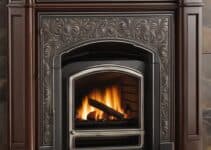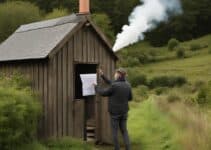As an aficionado of cosy evenings by the fire, I’m keenly aware of the importance surrounding the safety of wood stove door design. In crafting my analysis, it is clear that every element, from the strategic placement to the robust materials used, plays a critical role in log burner door safety. It’s not mere aesthetics; these features are a shield against potential hazards, ensuring that a tranquil night remains just that—peaceful and safe.
Distinctive safety features for log burner doors are not an afterthought; they are meticulously engineered to protect and provide comfort. Adhering to stringent installation and maintenance guidelines ensures that the wood stove serves as a reliable source of heat, rather than a liability. It’s a narrative that champions caution and prudence, where regular inspections and the correct usage of seasoned hardwood become integral practices for anyone who treasures the crackling serenity of a log burner.
Understanding the Importance of Wood Stove Door Safety
As an advocate for safeguarding households, I recognise that wood stove door safety is an integral aspect of ensuring a peaceful and hazard-free living environment. In this section, we will delve into the various safety features that are necessary to prevent accidents, as well as the distinct standards and regulations that govern log burner door safety. These elements collectively contribute to a robust defence against potential fire hazards.
The Role of Safety Features in Preventing Accidents
The incorporation of high-calibre log burner door safety features is paramount in preserving the serenity of homes. From robust construction materials to the meticulous design of locking mechanisms, every detail is meticulously tailored to ensure the containment of fire and the protection from unwarranted exposure to heat.
- Heat-resistant handles safeguard against burns when operating the stove.
- Secure latches and hinges prevent the accidental opening of the stove door, thereby mitigating the risk of sparks and embers escaping.
- Quality door seals maintain the integrity of the combustion process, which is central to both safety and efficiency.
These preventative features effectively reduce the likelihood of fire-related accidents, guaranteeing that peace of mind is as steadfast as the warmth provided by the log burner.
Compliance with Safety Standards and Regulations
Adherence to log burner door safety standards is not only a recommendation but also a legal obligation that varies across different jurisdictions. The minutiae of these regulations may differ, yet their purpose remains consistent – to offer comprehensive protection through exhaustive protocols. Key safety standards include specific clearances from combustible materials, and requirements for stove guards to protect children and pets.
| Feature | Function | Regulatory Standard |
|---|---|---|
| Air-tight door seals | Prevent smoke leaks and maintain air quality | BS EN 13240:2001 |
| Toughened glass | Withstands high temperatures without shattering | BS 476-20:1987 |
| Non-combustible materials | Ensures the stove door does not ignite or contribute to a fire | BS EN 1856-2:2009 |
Only with the strict observance of these regulations can one be confident of the reliable operation within safe parameters. Whether via the discerning eye of a certified installer or through regular inspections by the local fire department, maintaining compliance is the cornerstone of wood stove door safety in every home.
Safety Features Log Burner Door
When I examine the essential components that constitute log burner door safety, I am immediately drawn to the well-engineered safety features that are prevalent in their designs. These are not simply add-ons but integral aspects that assure peace of mind while using these heating implements. Below, I have delineated the crucial safety features one should expect from a modern log burner door, as well as a helpful safety checklist for regular assessments.
Heat-resistant handles are a must, designed to resist high temperatures, and allow secure handling without the risk of burns. Secure latches on these doors are non-negotiable; they need to be robust enough to prevent any accidental opening, which could result in dangerous sparks or embers escaping. Another core safety feature is the presence of airtight sealing mechanisms. These are crucial as they retain all smoke and harmful emissions within the log burner, ensuring only clean air is present in the home.
Modern log burners often include innovative air wash systems that maintain clarity of the glass window, offering the dual function of visibility into the combustion chamber and prevention of soot accumulation which may pose a risk. Overheat protection systems play a pivotal role too, by preventing the burner from reaching unsafe temperatures that could compromise the stove’s integrity and that of the surrounding area.
Now, to maintain a high standard of safety, I adhere to a comprehensive log burner door safety checklist:
- Check for any damage to the door seals and replace if necessary.
- Ensure handles and latches are secure and functioning correctly.
- Audit the integrity of the air wash system for clear viewing.
- Regularly monitor and test overheat protection features.
- Inspect the door for signs of wear or damage, particularly before and after the heating season.
This safety checklist aligns with wider log burner door safety guidelines which dictate not only these safety features but also extend to include proper fuel usage, ensuring clearances around the burner are met, and confirming that installation and operation procedures are properly followed.
The key is to apply these safety features and practices diligently. That’s why, as a professional providing advice on log burner door safety, I always encourage users to regularly consult their safety features log burner door manual and engage with professionals for periodic servicing to preserve the safe operation of their stove.
Installation and Clearance: Fundamental Safety Steps
As a dedicated journalist who takes pride in delivering enlightening and practical advice, I must emphasise the importance of adhering to specific safety prerequisites when it comes to log burner door installation and clearance safety for wood stoves. It’s not merely a matter of following best practices, but meeting legal requirements that possess significant implications for the safety and functionality of log burners.
Professional Installation Criteria and Legal Requirements
The installation of a wood stove is not a DIY endeavour; it necessitates professional expertise. I highly recommend enlisting certified professionals who are well-versed in the current legal standards and can guarantee your log burner complies fully with local building regulations. A professional will ensure your stove is positioned with proper ventilation and the necessary clearances to protect against fire hazards, offering essential log burner door safety tips along the way. It is a legal mandate in certain areas that these installations are carried out by qualified individuals, underlining the seriousness of the task at hand.
Crucial Clearance Distances for Wood Stove Doors
Establishing the proper clearance distances between your wood stove and adjacent combustible materials is not just a precautionary tactic, but a vital component of a comprehensive safety strategy. These clearances are meticulously calculated to prevent overheating and the likelihood of accidental fires within your home.
| Wood Stove Component | Minimum Clearance Distance | With Heat Shield |
|---|---|---|
| Sides and Rear | 36 inches (91 cm) | 12 inches (30 cm) |
| Floor Protection (Front) | 18 inches (46 cm) | Same as without shield |
| Ceiling | 84 inches (213 cm) | Can vary based on stovepipe |
The figures tabulated above demonstrate the minimum spatial requirements for visualising the necessary room around a log burner. Utilising heat shields can often reduce the clearance needed, enhancing safety while saving space. My professional stance is that sticking to these guidelines is not merely a suggestion, but a foundational rule in safeguarding both your home and family.
Investing time in learning about proper log burner door installation and applying clearance safety for wood stoves are elemental steps I urge you to take seriously. Adoption of these measures can be the difference between a cosy evening by the fire and a call to the emergency services—a scenario we all wish to avoid.
Combustible Materials and Log Burner Door Safety
As an expert on log burner combustible materials safety, I’m acutely aware of the risks posed by improper placement and handling of combustible materials near log burners. It’s a subject that requires our undivided attention, especially as cooler months approach and log burners become a primary source of heat for many households. A prime aspect of adhering to log burner door safety regulations is ensuring that sufficient clearances are established and rigorously maintained to prevent heat transfer that could ignite nearby combustibles.
Let’s explore the significance of placing non-combustible materials within the vicinity of a log burner. One of the pivotal elements of safety is the use of shielding, commonly made of metal or other non-combustible materials, which serves to deflect heat away from sensitive areas. Not only does this safeguard against accidental fires, but it also ensures compliance with the stringent safety regulations that govern our use of these heating systems.
The following table provides a glance at recommended clearances from combustible materials, alongside the use of non-combustible shields:
| Placement | Clearance without Shield | Clearance with Shield |
|---|---|---|
| Sides | 36 inches | 12 inches |
| Rear | 36 inches | 6 inches |
| Floor (Beneath Stove) | 18 inches | 2 inches |
As we delve into the intricacies of log burner door safety, it becomes evident that materials such as paper products, kindling, and even household fabrics should never be stored too close to the burner. During operation, these materials can easily catch aflame if left within the proximity of the intense heat produced by the burner. It is, therefore, my responsibility to ensure that these materials are kept at a safe distance at all times, in keeping with established safety protocols.
Remember, safety is not just a set of guidelines; it is a practice that requires persistent vigilance and an uncompromising commitment to upholding the highest standards of fire safety around log burners.
Key Aspects of Log Burner Door Maintenance
My pursuit of log burner door maintenance is driven by an understanding that the longevity and performance of any log burner lies in the commitment to its upkeep. In this regard, I focus my attention on regular cleaning, chimney sweeping for safety, and the judicious selecting of firewood for log burners.
Regular Cleaning and Chimney Sweeping
At the core of maintaining a log burner’s efficacy is the vigilant clearing of ash and soot accumulation. Annual cleaning sessions with a robust wire brush are essential, specifically targeting the log burner door to guarantee a secure seal and prevent hazardous emissions. This task is complimented with the conducting of controlled, high-temperature fires which serve as a preventative measure against the buildup of creosote, a flammable by-product with the potential to escalate to chimney fires.
Furthermore, chimney sweeps play a pivotal role in the safety protocol of a wood stove system. By engaging in regular chimney sweeping, not only is the efficient ejection of soot and creosote achieved but it also invites professional scrutiny – a thorough assessment of the entire wood stove which can flag up any early signs of wear or potential safety issues.
Seasoning and Choosing the Right Firewood
Selecting appropriate firewood for a log burner is not a choice to be made casually. Hardwoods, renowned for their density like oak and maple, are preferred due to their long burn time and consistent heat output. It’s important that these woods are processed – cut and split to size – and allowed to air dry for at least a year. This careful seasoning reduces moisture content, thereby ensuring a more efficient burn and significantly diminishing the production of creosote.
- Identify hardwoods suitable for your log burner (oak, maple).
- Ensure logs are cut to the correct size for your stove.
- Air dry the wood for a minimum of one year.
- Store seasoned wood in a dry, ventilated space.
By adhering to these proactive steps in both cleaning and wood selection, I manage to extend the lifespan of my wood stove while also championing its safe operation. Consistency in these practices is not merely recommended but essential in cultivating a secure and enjoyable heat source for the home.
Conclusion
As we reach the end of our exploration into wood stove use safety, it’s paramount to understand that the safety of log burner doors demands an integrated approach. My experience tells me that by adhering strictly to installation and clearance recommendations, performing regular maintenance, and operating stoves correctly, one can significantly enhance the safety and efficacy of their wood-burning experience. These practices are not just suggestions; they are essential components that ensure the log burner door safety features play their role effectively.
Maintaining a safety-first mindset is crucial as I can personally attest to the peace of mind it brings. An informed user, who is well-versed in the right fuel selection and the nuances of burn management, can enjoy the comforting embrace of their log burner’s warmth without compromising safety. It is the intricate balance between the management of combustible materials, educated use of firewood, and diligent adherence to safety protocols that culminates in a secure and efficient heating situation. My aim throughout this article has been to arm you with the knowledge needed to utilise your log burner safely while still benefiting from its cosy output.
Finally, achieving and sustaining log burner door safety is reliant on a comprehensive understanding of the interlinked aspects of usage and maintenance. For those who instil these principles, the result will be a responsible and environmentally sound practice that conforms to the latest safety standards and regulations, ensuring long-term benefits and secure operation. In my professional experience, this level of diligence and education is the keystone to not just using a wood stove, but doing so with unmatched confidence in its safe performance.



